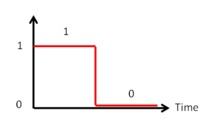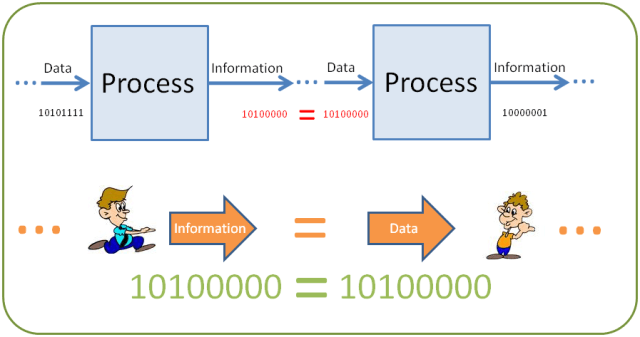Data Coding and Information Decoding
| |
Educational level: this is a secondary education resource. |
| |
Resource type: this resource is a lesson. |
| |
Completion status: this resource is ~75% complete. |
Unique Code
Data are Numbers, Text, Sounds, Image, Animation, Video, etc.; in order to define them in the real world, we are using Numbers (0,...9), an Alphabet (A,...Z) and symbols (@,[,\,...) or a combination of them, for example:
- 2012 ( Number )
- Wikiversity ( Alphabet )
- 3<5 ( combination of Number and symbol )
- X=(Y*Z)+W-U ( combination of Alphabet and symbols )
- N123 ( combination of Alphabet and Number )
Computers, however, don't understand the definitions for Numbers (0,...9), the Alphabet (A,...Z) and symbols (@,[,\,...), so in order to process those pieces of information a unique code must be assigned to each of them. The unique code for Numbers (0,...9), the Alphabet (A,...Z) and symbols (@,[,\,...) is a binary numeral.

In practical use, each "0" and "1" in binary number uses a Physical attribute that is electrical or magnetic. The smallest part of that Physical attribute is named "Bit", the existence of the Physical attribute is "1", and the absence of the Physical attribute is "0"; 8-bit grouped up are called 1 Byte (so 1 byte=8 bit).
The binary numeral system, or base-2 number system, represents numeric values using two symbols - 0 and 1.
Examples:
- numerical value " 0 " is 0. The unique code for 0 is → 00000000
- numerical value " 1 " is 1. The unique code for 1 is → 00000001
- numerical value " 2 " is 10. The unique code for 2 is → 00000010
- numerical value " 3 " is 11. The unique code for 3 is → 00000011
- numerical value " 4 " is 100. The unique code for 4 is → 00000100
- numerical value " 5 " is 101. The unique code for 5 is → 00000101
- numerical value " 6 " is 110. The unique code for 6 is → 00000110
- numerical value " 7 " is 111. The unique code for 7 is → 00000111
- numerical value " 8 " is 1000. The unique code for 8 is → 00001000
- numerical value " 9 " is 1001. The unique code for 9 is → 00001001
Alphabet (A,...Z):
- The unique code for " A " is → 01000001
- The unique code for " B " is → 01000010
- The unique code for " C " is → 01000011
- .....
- .....
- .....
- The unique code for " Z " is → 01011010
for symbols ():
- The unique code for " @ " is → 01000000
- The unique code for " [ " is → 01011011
- The unique code for " \ " is → 01011100
- .....
- .....
- .....
Distinction between "Data" and "Information"
